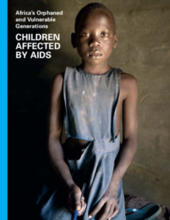The AIDS epidemic in Africa puts children at risk physically, emotionally and economically. All children are indirectly affected when their communities, and the services these communities provide, are strained by the consequences of the epidemic. Nurses, doctors, teachers and others can become ill and die from AIDS, affecting health care, education and other basic services.
Children are directly affected in a number of ways. They may live at high risk of HIV; they may live with a chronically ill parent or parents and be required to work or put their education on hold as they take on household and caregiving responsibilities; their households may experience greater poverty because of the disease; and they can be subject to stigma and discrimination because of their association with a person living with HIV. Children can also become orphans, having lost one or both parents to AIDS-related illnesses.
In sub-Saharan Africa, AIDS is the leading cause of death among adults ages 15–59. Although the total number of orphans from all causes in Asia and in Latin America and the Caribbean since 1990 has been decreasing, the number of orphans from all causes has risen by more than 50 per cent in sub-Saharan Africa, where an estimated 12 million children ages 0–17 have lost one or both parents to AIDS. This makes the region home to 80 per cent of all the children in the developing world who have lost a parent to the disease. Children are experiencing the greatest parental loss in southern Africa, where HIV prevalence rates are highest. By 2010, an estimated 15.7 million children – 30 per cent of the 53 million anticipated orphans from all causes in sub-Saharan Africa – will have lost at least one parent due to AIDS. Even where HIV prevalence stabilizes or begins to decline, the number of orphans will continue to grow or at least remain high for years, reflecting the time lag between HIV infection and death. The experiences of orphaned and vulnerable children vary significantly across families, communities and countries. Some studies have shown that orphans and vulnerable children are at higher risk of missing out on schooling, live in households with less food security, suffer anxiety and depression, and are at higher risk of exposure to HIV. The situation is influenced by a complex mix of variables, including children’s relationship to their caregivers, the wealth of their household and community, HIV prevalence in the community and an array of other factors. In almost every country in the region, there are notable differences between the responsibilities assumed by fathers and mothers, with widowed mothers more likely to be responsible for the care of their children than widowed fathers, making children who lose their mothers less likely to live with the surviving parent compared to children who lose their fathers. Furthermore, the survival of the youngest children (ages 0–3) is at stake when their mothers are dying or have recently died. This is true whether the mother dies of AIDS or other causes. Children of this age group are 3.9 times more likely to die in the year before or after their mother’s death.
Extended families care for the vast majority of orphans and vulnerable children in sub-Saharan Africa, in many countries assuming responsibility for more than 90 per cent of all double orphans and single orphans not living with the surviving parent. Within a household, the nature of the relationship between the new caregiver and the child strongly influences the outcome for the child. Several studies have shown that the closer children remain to their biological family, the more likely they are to be well cared for and the greater the chance that they will go to school consistently, regardless of poverty level. While families have cared for the expanding number of orphans and vulnerable children in sub-Saharan Africa, in places with advanced epidemics, there is some indication that children can end up in poorer households and that available caretakers are becoming scarcer and more impoverished.
The implications of the AIDS epidemic for generations of orphans and vulnerable children in sub-Saharan Africa are serious, but governments, international agencies, non-governmental organizations and community groups can alter the course of the response. Some challenges can be addressed by providing support to caregivers, extended families and communities. Others, including equitable access to education and health, birth registration, foster care and inheritance legislation, also require commitment and intervention from governments. In recent years, there has been a surge in leadership and resources for them fight against AIDS. In 2005, approximately $8.3 billion was available for responding to the epidemic. While a long-needed influx of funds has great potential for improving the lives of millions of children affected by the disease, the multisectoral nature of HIV response makes tracking difficult at the country level, so it is not known what percentage of this money is specifically helping children.
©UNICEF

